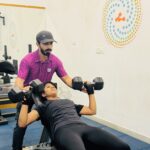At Tarun Sardesai Golf (TSG), every weekend is more than just another session – it’s an immersion into the finer aspects of golf that most overlook. Our latest gathering with the golfers was focused on an essential yet often underappreciated part of the game: chipping. Led by our Senior Coach, Murtaza Raja, the session went beyond technique, taking players into the minds of great short-game artists who know how to read the Lie, evaluate the turf, and shape a chip shot with intention. And it all began with one golden rule – don’t become a robot.
Our coach made it clear from the outset: chipping is not a paint-by-numbers technique. You can’t rely on a textbook move to get you through every type of grass, slope, or condition. When golfers start thinking mechanically, they lose the essence of adaptability, which is critical in short-game scenarios. Instead, chipping should be reactive and fluid – an answer to the environment around you.
The heart of the discussion centered around one concept that underpins all others in the short game: the Lie.
This single factor influences distance control, spin, shot height, and even the contact you can make. And yet, so many golfers fail to adjust their approach based on it. The discussion began with a simple question: would you chip the same way from a tight fairway as you would from thick rough? The answer was, of course, a resounding NO.
As the session progressed, we looked at different types of Lie and how each demanded a different adaptation level. From fairways offering clean, spin-friendly contact to thick, tangled rough that robs you of control, each condition asks the golfer a different question. On tightly mown fairways with no grass between the club and the ball, you can create higher spin and exert better control over the ball’s flight. But as the ball settles deeper into medium or thick rough, spin becomes more challenging to generate, trajectory lowers, and the margin for error narrows significantly.
Interestingly, the grass became a topic of deep discussion – its length and the direction it grows. Grass often grows along the slope of the land, and this directional growth influences club interaction. For example, the golfer usually plays against the grass grain on an uphill Lie, resulting in less spin in the shot. More spin can be generated while playing on a downhill slope, where the grass is in the direction of playing the shot. These seemingly subtle and small things tremendously change how a chip shot behaves entirely.
Then, there’s the slope of the Lie, which adds another layer of complexity in the game. A downhill slope naturally produces lower chips, while an uphill slope provides more loft to the ball. When you combine this factor of the play with the type and direction of the grass, the golfer can be said to be solving a puzzle with multiple moving parts.
Firmness of the ground also played a key role in the discussion. Lies were categorized into five types:
- hard pan (extremely dry and compact),
- fairway (moderately firm),
- soft fairway (with a slight give),
- rough (dense and unpredictable), and
- moist lies (with dew or water present).
Moist Lie, in particular, is tricky – spin is reduced due to the water acting as a barrier between the ball and clubface, making the shot more unpredictable. Understanding the behavior of the turf beneath the ball is crucial to predicting the ball’s flight and roll-out.
Coach Murtaza also emphasized on the importance of making sound decisions under pressure. He presented a scenario where the hole was just three yards away from the edge of the green, with a three-yard rough and a fast green to manage. The shot demanded a high spin and a low-energy chip that could land softly and stop quickly. Such real-world simulations helped players visualize the relationship between the Lie, the intended trajectory, and the spin required for the ball to behave as expected on the green.
What truly set this session apart was the focus on contact. Two types of contact were highlighted – compressed and non-compressed.
- A compressed contact is where the ball is struck before the turf, which is essential for tough Lie.
- Non-compressed contact, where the club bottoms out slightly before the ball and uses bounce effectively, is better suited for softer lies.
Protip: Adjusting the shaft lean, ball position, and weight distribution helps players control the low point of their swing and manage contact quality.
To validate these insights, the team at TSG use technology like Trackman to run live tests. One such experiment compared draw chips to cut chips. The draw chip showed higher spin and more significant release thanks to its higher smash factor. Meanwhile, cut chips offered less spin and stopped quicker—perfect for tight landing areas and paramount control.
These little off-the-greens learnings helped golfers understand that there’s no one-size-fits-all chipshot and no particular way to address the versatility of the game. The correct technique depends entirely on the Lie, turf conditions, and desired shot outcome. The session concluded with one powerful message: chipping is not just a shot; it’s a solution.
Every Lie is a challenge, every slope a variable, and every shot an opportunity to make a wise decision. At TSG, we don’t just teach players how to execute. We teach them to think—analyze the Lie, visualize the shot, and commit to a plan. It elevates awareness, creativity, and decision-making—qualities defining great golfers.
Here’s to embracing the grind, reading the ground, and turning every chip into a calculated move. Until next time, happy golfing!



